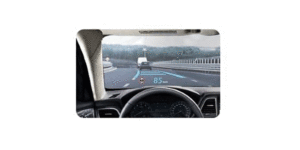JVCKENWOOD Corporation of Japan has developed a technology to improve the image on aftermarket, OEM and other Heads Up Displays (HUDs).
The company’s new technology reduces the “double images” produced when an HUD is projected onto a standard windshield. The technology is timely as more HUDs are expected to play a role in Augmented Reality in the car. HUDs are also growing more common in Advanced Driver Assistance Systems (ADAS) in automobiles.
When an HUD typically displays speed, navigation cues and other information, the information is projected from a dashboard device to the windshield. However, when projected directly on the windshield, it creates a double image due to reflections on the other side of the glass. Some use a reflective film on the windshield to improve the image but this can obstruct the driver’s view.
JVCKENWOOD is using its video, optical and in-car technology to solve the problem, it announced.
It’s technology basically aligns the reflections on both sides of the glass. It doesn’t add a new optical component to a concave mirror, as do some other solutions, which are more costly. “Therefore, this technology is expected to be applied to low-priced vehicles, as well as to be mounted outside vehicle assembly lines because conventional windshields can be used,” said JVCKENWOOD, which also expects the technology do be used in the aftermarket and even in non-automotive applications “such as entertainment and signage,” said the company in a press announcement.
The company is pursuing a patent on the technology.
Source: JVCKenwood

